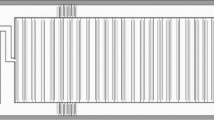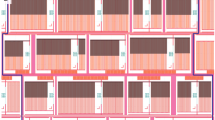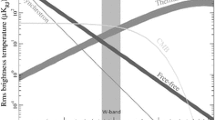Abstract
The next generation of far infrared radiation detectors is aimed to reach photon noise limited performance in space based observatories such as SPICA and BLISS. These detectors operate at loading powers of the astronomical signal of a few Attowatt (10−18 W) or less, corresponding to a sensitivity expressed in noise equivalent power as low as \(\mathrm{NEP} = 2\times10^{-20}\ \mbox{W}/\sqrt{\mathrm{Hz}}\). We have developed a cryogenic test setup for microwave Kinetic Inductance Detectors (MKIDs) that aims to reach these ultra-low background levels. Stray light is stopped by using a box in a box design with a sample holder inside another closed box. Microwave signals for the MKID readout enters the outer box through custom made coax cable filters. The stray light loading per pixel is estimated to be less than 60×10−18 W during nominal operation, a number limited by the intrinsic sensitivity of the MKIDs used to validate the system.



Similar content being viewed by others
References
Detector Needs for Long Wavelength Astrophysics: A Report by the Infrared, Submillimeter, and Millimeter Detector Working Group. http://safir.gsfc.nasa.gov/docs/ISMDWG_final.pdf (2002)
P.K. Day et al., Nature 425 (2003)
R. Barends, J. Wenner, M. Lenander, Y. Chen, R.C. Bialczak, J. Kelly, E. Lucero, P. O’Malley, M. Mariantoni, D. Sank, H. Wang, T.C. White, Y. Yin, J. Zhao, A.N. Cleland, J.M. Martinis, J.J.A. Baselmans, Appl. Phys. Lett. 99, 113507 (2011)
M. Lenander, H. Wang, R.C. Bialczak, E. Lucero, M. Mariantoni, M. Neeley, A.D. O’Connell, D. Sank, M. Weides, J. Wenner, T. Yamamoto, Y. Yin, J. Zhao, A.N. Cleland, J.M. Martinis, Phys. Rev. B 84, 024501 (2011)
S. Doyle, P. Mauskopf, J. Naylon, A. Porch, C. Duncombe, J. Low Temp. Phys. 151, 530–536 (2008)
J. Baselmans, S. Yates, AIP Conf. Proc. 1185, 160–163 (2009)
J. Baselmans, S.J.C. Yates, R. Barends, Y.J.Y. Lankwarden, J.R. Gao, H. Hoevers, T.M. Klapwijk, J. Low Temp. Phys. 151(1–2), 524–529 (2008)
M.C. Diez, T.O. Klaassen et al., in UV, Opt. and IR Space Telescopes and Instr., vol. 4013 (2000), pp. 129–139
P. Hargrave, Nucl. Instrum. Methods Phys. Res., Sect. A, Accel. Spectrom. Detect. Assoc. Equip. 444, 427–431 (2000)
J.W. Lamb, Int. J. Infrared Millim. Waves 17, 12 (1996)
F.P. Milliken et al., Rev. Sci. Instrum. 78, 024701 (2007)
P.J. de Visser, J.J.A. Baselmans, P. Diener, S.J.C. Yates, A. Endo, T.M. Klapwijk, Phys. Rev. Lett. 106, 167004 (2011)
S.J.C. Yates, J.J.A. Baselmans, A. Endo, P. Diener, L. Ferrari, A.M. Baryshev, Appl. Phys. Lett. (2012, submitted)
P.J. de Visser, J.J.A. Baselmans, P. Diener, S.J.C. Yates, A. Endo, T.M. Klapwijk, these proceedings (2011)
Author information
Authors and Affiliations
Corresponding author
Rights and permissions
About this article
Cite this article
Baselmans, J., Yates, S., Diener, P. et al. Ultra Low Background Cryogenic Test Facility for Far-Infrared Radiation Detectors. J Low Temp Phys 167, 360–366 (2012). https://doi.org/10.1007/s10909-012-0511-0
Received:
Accepted:
Published:
Issue Date:
DOI: https://doi.org/10.1007/s10909-012-0511-0




